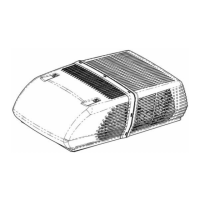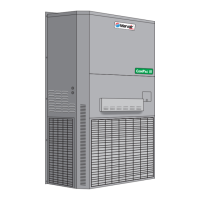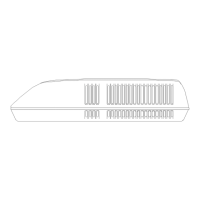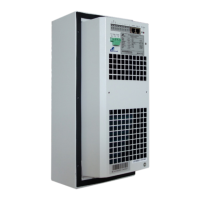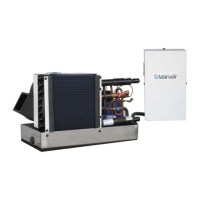2
I. GENERAL INFORMATION
OEM – Please make sure all documentation
accompanies the heat pump.
INSTALLER AND/OR DEALER – Please make sure
all documentation is presented to the product
consumer. The product consumer should also be
afforded the opportunity to purchase the OPTIONAL
THREE (3) YEAR PARTS REPLACEMENT
CONTRACT available from Airxcel, Inc.
For more information about the contract, please review
the sample contract located at
www.Airxcel.com/Warranty. Use the application on the
back of the OPERATION AND MAINTENANCE
INSTRUCTIONS to apply for the extended parts
contract.
INQUIRIES ABOUT THE UNIT – Inquiries to your
AIRXCEL, Inc. representative or to Airxcel, Inc.
pertaining to product installation should contain both
the model and serial numbers of the roof top heat
pump. These rooftop heat pumps have model and
serial number identification in two locations: (1) Rating
Plate sticker - may be viewed by removing the rooftop
unit shroud. The rating plate is on top of the evaporator
cover. (2) Model/Serial number sticker located on the
return air flange on the rooftop unit base pan.
II. HEAT PUMP SIZING
Heat pumps should be rated primarily by their ability to
cool. The ability of a heat pump to provide a
comfortable environment for the consumer is
dependent upon the following:
The ability of a heat pump to cool down a vehicle or
maintain a consumer desired temperature is dependent
on the heat gain of the vehicle. The physical size of the
vehicle, the amount of window area, the quality and
amount of insulation, the exposure to sunlight, the
number of people using the vehicle and the outside
temperature may increase the heat gain to such an
extent that the capacity of the heat pump is exceeded.
As a general rule, air supplied (discharge air) from the
heat pump will be 15 to 20 degrees F cooler than the
air entering (return air) the ceiling assembly bottom air
grilles.
For example, if the air entering the heat pump is 80
degrees F - (return air), the supply air (discharge air)
into the vehicle will be 60 to 65 degrees F. As long as
this temperature difference (15 to 20 degrees F) is
being maintained, the unit is operating properly.
Again, give careful consideration to the vehicle heat
gain variables. During extreme outdoor temperatures,
the heat gain of the vehicle may be reduced by:
• Parking the vehicle in a shaded area
• Keeping window and doors closed
• Avoiding the use of heat producing appliances
• Using window shades (blinds and/or curtains)
For a more permanent solution to high heat gain
situations, additional vehicle insulation, window
awnings and /or glass tinting should be considered.
III. SELECTING AN INSTALLATION LOCATION
Your Airxcel, Inc. heat pump has been designed for use
primarily in recreational vehicles.
Is the roof capable of supporting both the roof top unit
and ceiling assembly without additional support
structures? Inspect the interior ceiling mounting area to
avoid interference with existing structural members
such as: bunks, curtains, tracks or room dividers. The
depth of the ceiling assembly shroud is 3”. Be sure to
check clearance to doors which must be swung open
(refrigerator – closets – cabinets).
Most of the time, roof mount heat pumps are installed
at existing roof vent locations. If there are no roof vent
(existing mounting hole), the following placement
locations are recommended:
Motorhomes – a single unit or the forward of two units
should be mounted within 9 feet of the driver’s
compartment.
Travel Trailers or Mini-Homes – a location should be
selected that is near the door slightly forward of the
vehicle center length.
Vans – location should be in the center of the roof (side
to side – front to back).
Truck with Camper – location should be between 4 to
5 feet from the rear of the camper to achieve maximum
cooling effect.
IV. INSTALLING THE ROOF TOP UNIT
DANGER! SHOCK HAZARD DISCONNECT ALL
POWER TO THE VEHICLE BEFORE
PERFORMING ANY CUTTING TO THE VEHICLE.
CONTACT WITH HIGH VOLTAGE CAN RESULT
IN EQUIPMENT DAMAGE, PERSONAL INJURY
OR DEATH.
IMPORTANT
TO PREVENT DAMAGE TO THE WIRING AND
BATTERY, DISCONNECT THE BATTERY CABLE
FROM THE POSITIVE BATTERY TERMINAL
BEFORE PERFORMING ANY CUTTING TO THE
VEHICLE.
This heat pump is to be installed in accordance with
NFPA Standard 501C.
If the heat pump is being installed on a low friction roof
surface such as aluminum, steel or gelcoat fiberglass,
it is advisable to order a spring pad kit, part number
8333-3871, to add “spring pads” to maintain bolt
tension and retard lateral motion of the heat pump
which could shear the mounting bolts. If the heat pump
is being installed subject to heavy lateral loads, it is
advisable to order a “Roughneck” gasket/bolt package,
part number 48207-3301 to maintain bolt tension,
prevent lateral movement of the heat pump and guard
against bolt shear.
Once the location for your heat pump has been
determined (See Section III), a reinforced and framed
roof hole opening must be provided (may use existing
roof vent opening). Before cutting into the vehicle roof,
verify that the cutting action will clear all structural
members and crossbeams. Additionally, the location of
any inner roof plumbing and electrical supplies must be
considered.
A. If a roof vent is already present in the desired
mounting location for the heat pump, the following
steps must be taken.
1. Remove all screws which secure the roof vent to
the vehicle. Remove the vent and any additional
trim materials. Carefully remove all caulking from
around the roof opening to obtain clean exterior
roof surface.
2. It may be necessary to seal some of the old roof
vent mounting screw holes which may fall outside
of the heat pump basepan gasket.
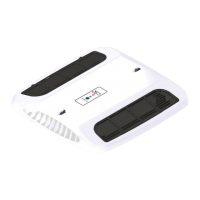
